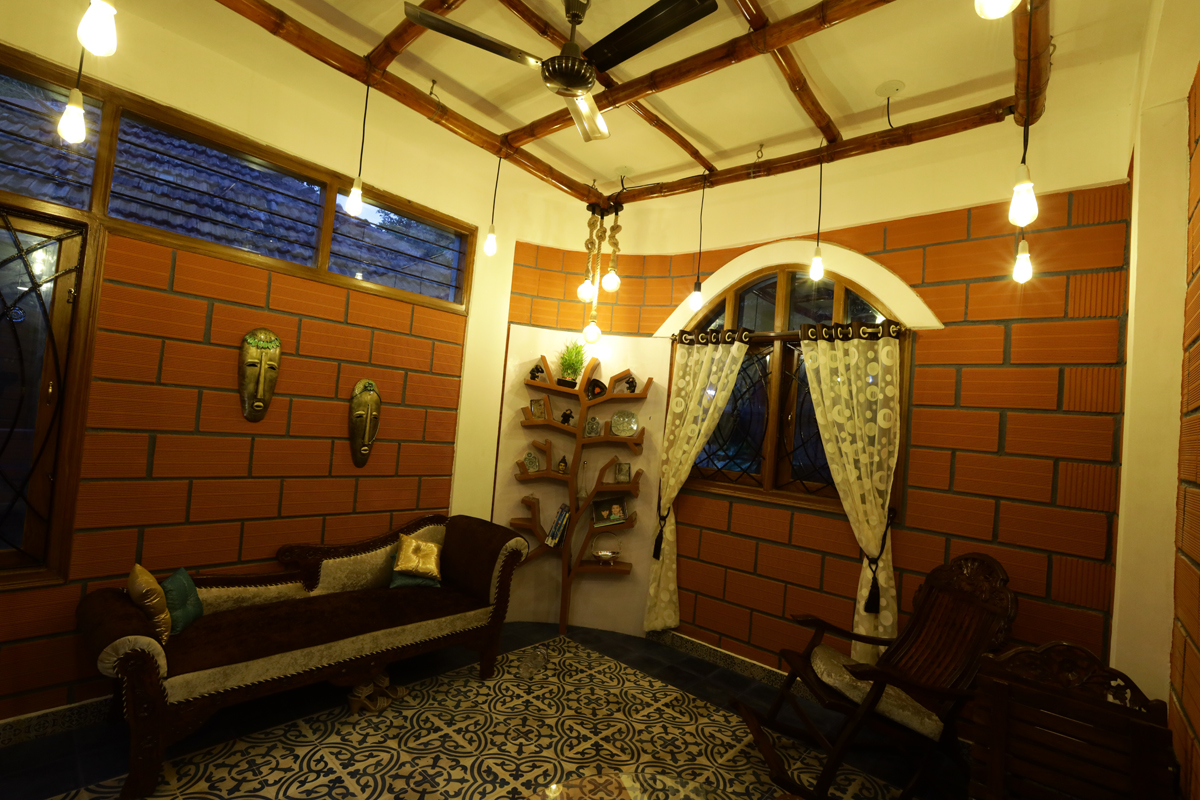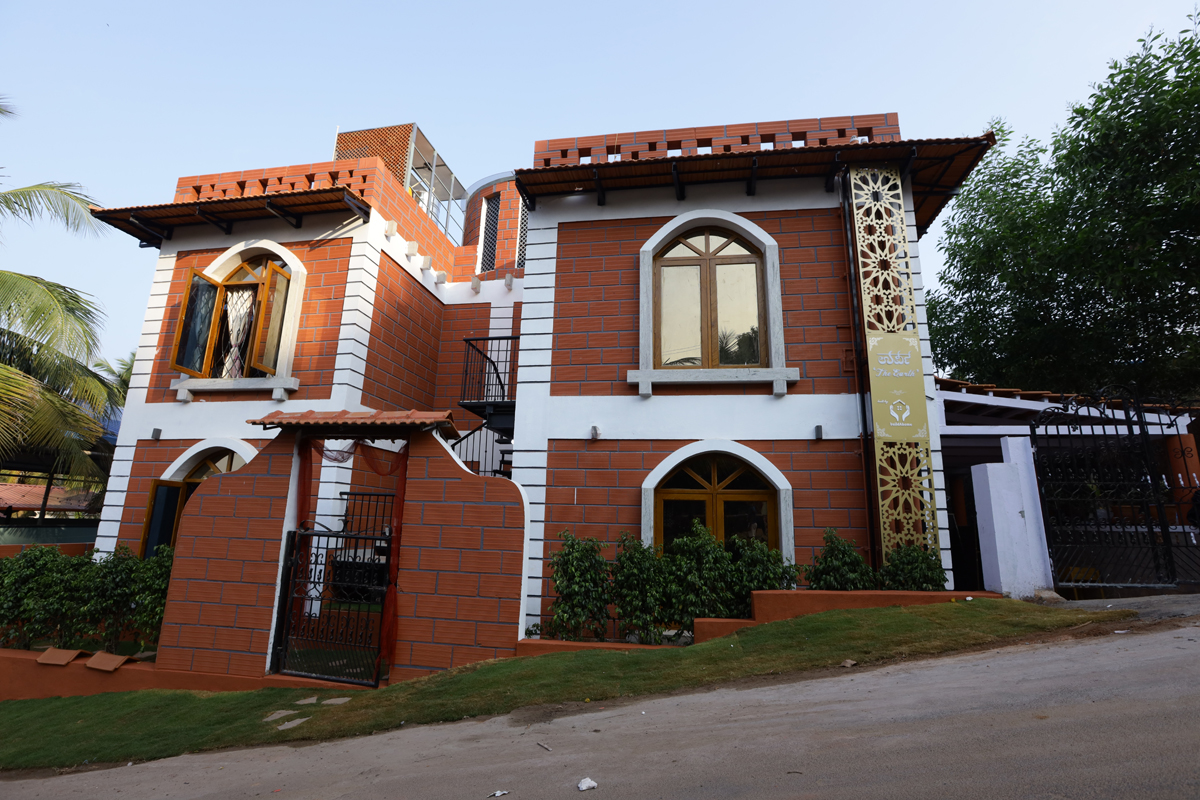This Bengaluru Engineer’s Green, Innovative & Low-Cost Home Is Perfect for Us All
“Reclaimed wood from demolished houses fulfilled the entire wood requirement of the home. Not a single tree was cut down. I feel our biggest achievement in this house is to keep it cool naturally, in a place like Mangaluru."

Home is not a place, it is a feeling, and those of us looking to build one want to ensure that every detail aligns with our idea of a ‘home.’
If you are someone who lives a conscious life, you would be well aware of the impact that constructing and maintaining a home, can have on the environment.
So, building an eco-friendly house seems either impractical, unaffordable or both.
But what if there is a way to equip your home with all the modern amenities while ensuring that the cost—to your pocket and the environment—is minimal?
The Better India spoke to Abhijit Priyan, the CEO of Build a Home (BAH) an organization which provides end-to-end solutions for cost-effective homes.
Abhijit, an engineer from Bengaluru, recently worked on a house in Mangaluru, Karnataka and made it as eco-friendly as possible.

He replaced traditional bricks, cement and design ideas with sustainable architectural methods that cause minimal carbon impact.
Speaking to The Better India, Abhijit said, “The first challenge we faced was the location itself. Mangaluru is a city that enjoys only two seasons—extremely hot summers and heavy monsoons. We wanted to build a home that was cool by design and would not require fans or ACs. The heavy rains were also a hurdle.”
The necessity to overcome the twin obstacles of heat and water is what led to the birth of Urvi, the house named after the earth.
1. Replacing the conventional with the eco-friendly.

Cement is one of the most harmful materials used during construction. If you have lived near a site which is under construction, you would know the inconvenience that this can cause.
So, the architects and engineers of Urvi decided to replace cement with Porotherm—a hollow block walling system made of clay which is just as efficient as a standard brick. However, it is more sustainable and uses about 95% less water during construction.
“Incidentally, we did not plaster the walls either and used Porotherm itself as the finished product,” Abhijit says, adding that “This move saved a lot of cement and sand. However, this is a process that requires very careful and intrinsic work that only experts can undertake.”
This secured the walls and slabs. But what about the pillars?
“Reclaimed wood from demolished houses fulfilled the entire wood requirement of the home. Not a single tree was cut down,” says Abhijit.
Next in line was the question of ventilation, air and cooling. Who doesn’t like a breezy home with ample natural light? However, in the race to get the highest standing house in the urban jungles, often we miss out on this aspect.
But not BAH.
The architects used a high-performance glass on the roof as skylights and ventilator turbines—the kind you see on the roofs of warehouses—to make sure that the house was well-lit and perfectly ventilated.
“I feel our biggest achievement in this house is to keep it cool naturally, in a place like Mangaluru,” says Abhijit.

To reduce the use of water, the designers used the resource at hand—rains!
“The home runs on rainwater during the rainy season, and in the other seasons, water from the borewell water is used,” he explains. “The underground tanks have a capacity of over 50,000 litres, and the recharge pits spread all across the home recharge the groundwater, facilitating the improvement of water levels. The house also recycles its water in what is called a ‘grey water filtration technique.’ In this, the water from the sinks, the kitchens and the showers gets recycled and is used for flushing and landscaping purposes. So compared to a typical house, this house uses every litre of water 1.6 times.”
You may also like: Bengaluru Architect Builds Unique ‘Insta House’ That Can Be Installed In a Day!
In addition, the architects experimented with bamboo for the false ceiling, earthen pots and filler slabs for the concrete structure and even used old unusable Vinyl CDs to build the floor of the music room!
Solar water heaters were installed on the roof, and explaining what the designers did with the waste materials, Abhijit says, “All the wastage of these materials and granite is used in the terrace. The terrace has a high-performing thermally insulated waterproofed membrane which is protected by these broken tiles which retard the slab from heating.”
2. The resources employed

This unconventional house needed a team of creative, eco-conscious experts who could build a sturdy, sustainable structure in the coastal town.
A full-time engineer was employed at the site who oversee the construction from start to finish. Apart from that, BAH provided architects, designers and back office support as and when needed. Carpenters, labourers, tradesmen, masons, fabricators, glass fitters, painters, tile layers etc., were employed as and when their services were required.
You may also like: This New Tech By Kerala Architects Could Build Post-Flood Houses Under Rs 5 Lakh!
“All the materials for the project were sourced locally in Mangalore. Clay blocks, clay jaali tiles, earthen pots, bamboo false ceiling etc. were all locally available. Certain artisan works like Athanagudi tiles were sourced out of Mangalore, but all other materials were sourced locally,” Abhijit informs us, adding that the glass fitters were full-time Saint Gobain employees.
He added that the entire process took about ten months.
3. How expensive is a house like this?

“The house cost about 57 lakhs to build. This includes the architecture, design, and construction of the entire home including electrical and plumbing work. The cost also included Government liaison (plan sanction, completion certificate etc.), interior design and execution of the interiors (kitchens, wardrobes, false ceiling etc.) The cost of solar panels, solar water heater, all the filters in the house, as well as landscaping inside and outside the house is also included,” said Abhijit.
Your home can be anything you want it to be. And with examples like Urvi, we know how to make them green, sustainable and eco-friendly without giving up on aesthetics or amenities!
(Edited by Gayatri Mishra)
Like this story? Or have something to share? Write to us: [email protected], or connect with us on Facebook and Twitter.
If you found our stories insightful, informative, or even just enjoyable, we invite you to consider making a voluntary payment to support the work we do at The Better India. Your contribution helps us continue producing quality content that educates, inspires, and drives positive change.
Choose one of the payment options below for your contribution-
By paying for the stories you value, you directly contribute to sustaining our efforts focused on making a difference in the world. Together, let’s ensure that impactful stories continue to be told and shared, enriching lives and communities alike.
Thank you for your support. Here are some frequently asked questions you might find helpful to know why you are contributing?


This story made me
-
97
-
121
-
89
-
167











